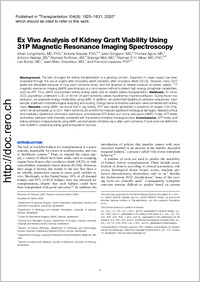Ex vivo analysis of kidney graft viability using 31p magnetic resonance imaging spectroscopy
- Longchamp, Alban Department of Vascular Surgery, Centre Hospitalier Universitaire Vaudois and University of Lausanne, Lausanne, Switzerland.
- Klauser, Antoine Department of Radiology and Medical Informatics, University of Geneva, Geneva, Switzerland. - Center for Biomedical Imaging (CIBM), Geneva, Switzerland.
- Songeon, Julien Department of Radiology and Medical Informatics, University of Geneva, Geneva, Switzerland.
- Agius, Thomas Department of Vascular Surgery, Centre Hospitalier Universitaire Vaudois and University of Lausanne, Lausanne, Switzerland.
- Nastasi, Antonio Visceral and Transplant Surgery, Department of Surgery, Geneva University Hospitals and Medical School, Geneva, Switzerland.
- Ruttiman, Raphael Visceral and Transplant Surgery, Department of Surgery, Geneva University Hospitals and Medical School, Geneva, Switzerland.
- Moll, Solange Division of Clinical Pathology, Department of Pathology and Immunology, Geneva University Hospital and Medical School, Geneva, Switzerland.
- Meier, Raphael P. H. Visceral and Transplant Surgery, Department of Surgery, Geneva University Hospitals and Medical School, Geneva, Switzerland. - Department of Surgery, University of Maryland School of Medicine, Baltimore, MD, USA.
- Bühler, Leo Faculty of Science and Medicine, Section of Medicine, University of Fribourg, Switzerland
- Corpataux, Jean-Marc Department of Vascular Surgery, Centre Hospitalier Universitaire Vaudois and University of Lausanne, Lausanne, Switzerland.
- Lazeyras, François Department of Radiology and Medical Informatics, University of Geneva, Geneva, Switzerland. - Center for Biomedical Imaging (CIBM), Geneva, Switzerland.
-
2020
Published in:
- Transplantation. - 2020, vol. 104, no. 9, p. 1825–1831
English
Background: The lack of organs for kidney transplantation is a growing concern. Expansion in organ supply has been proposed through the use of organs after circulatory death (donation after circulatory death [DCD]). However, many DCD grafts are discarded because of long warm ischemia times, and the absence of reliable measure of kidney viability. 31P magnetic resonance imaging (pMRI) spectroscopy is a noninvasive method to detect high-energy phosphate metabolites, such as ATP. Thus, pMRI could predict kidney energy state, and its viability before transplantation.Methods: To mimic DCD, pig kidneys underwent 0, 30, or 60 min of warm ischemia, before hypothermic machine perfusion. During the ex vivo perfusion, we assessed energy metabolites using pMRI. In addition, we performed Gadolinium perfusion sequences. Each sample underwent histopathological analyzing and scoring. Energy status and kidney perfusion were correlated with kidney injury.Results: Using pMRI, we found that in pig kidney, ATP was rapidly generated in presence of oxygen (100 kPa), which remained stable up to 22 h. Warm ischemia (30 and 60 min) induced significant histological damages, delayed cortical and medullary Gadolinium elimination (perfusion), and reduced ATP levels, but not its precursors (AMP). Finally, ATP levels and kidney perfusion both inversely correlated with the severity of kidney histological injury.Conclusions: ATP levels, and kidney perfusion measurements using pMRI, are biomarkers of kidney injury after warm ischemia. Future work will define the role of pMRI in predicting kidney graft and patient’s survival.
- Faculty
- Faculté des sciences et de médecine
- Department
- Master en médecine
- Language
-
- English
- Classification
- Medicine
- License
- License undefined
- Identifiers
-
- RERO DOC 329469
- DOI 10.1097/TP.0000000000003323
- Persistent URL
- https://folia.unifr.ch/unifr/documents/308876
Statistics
Document views: 101
File downloads:
- buh_eva.pdf: 227
